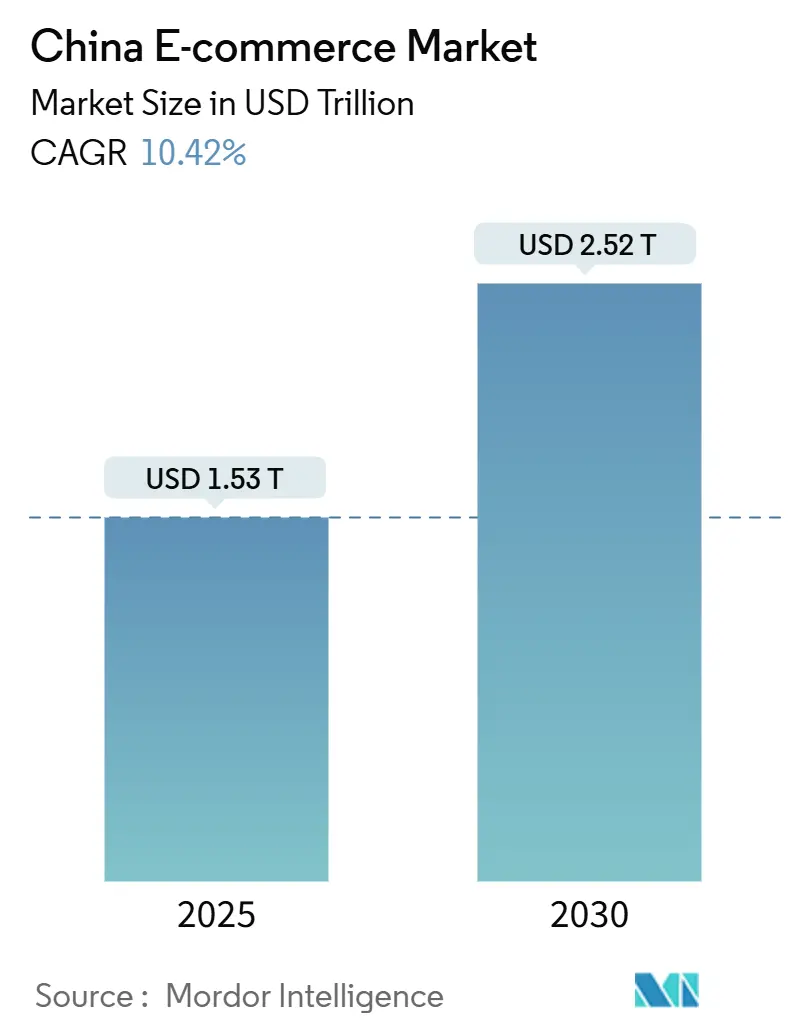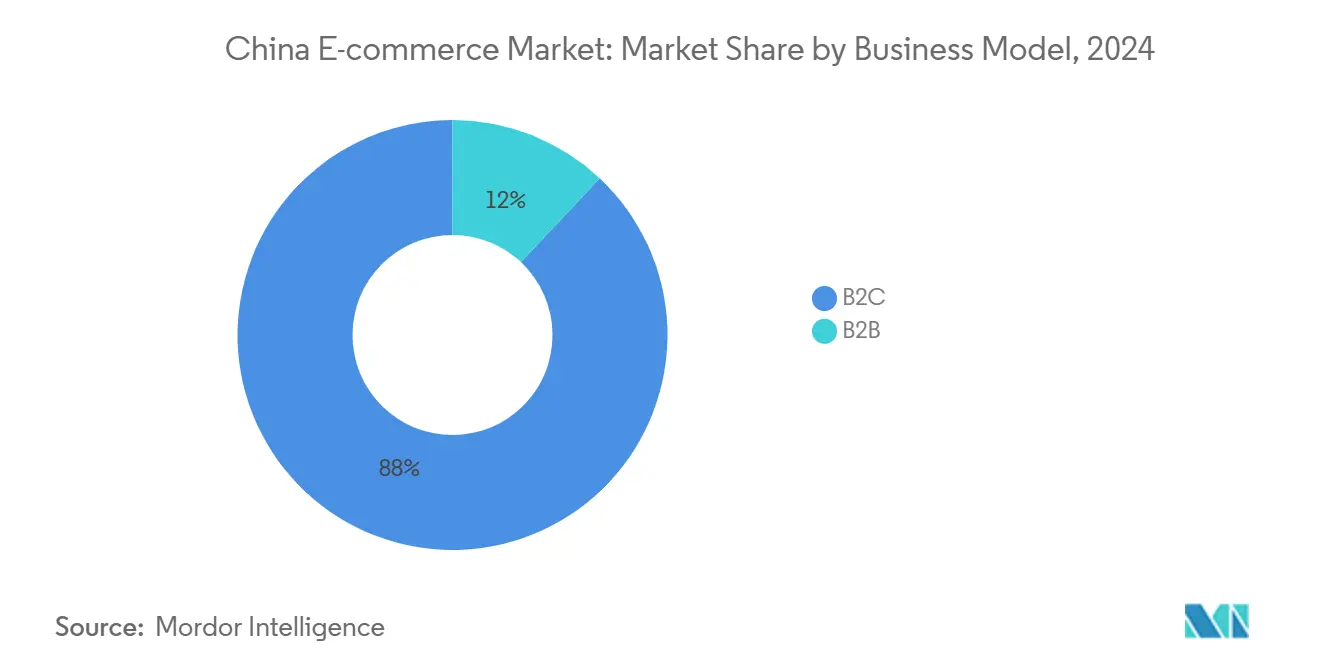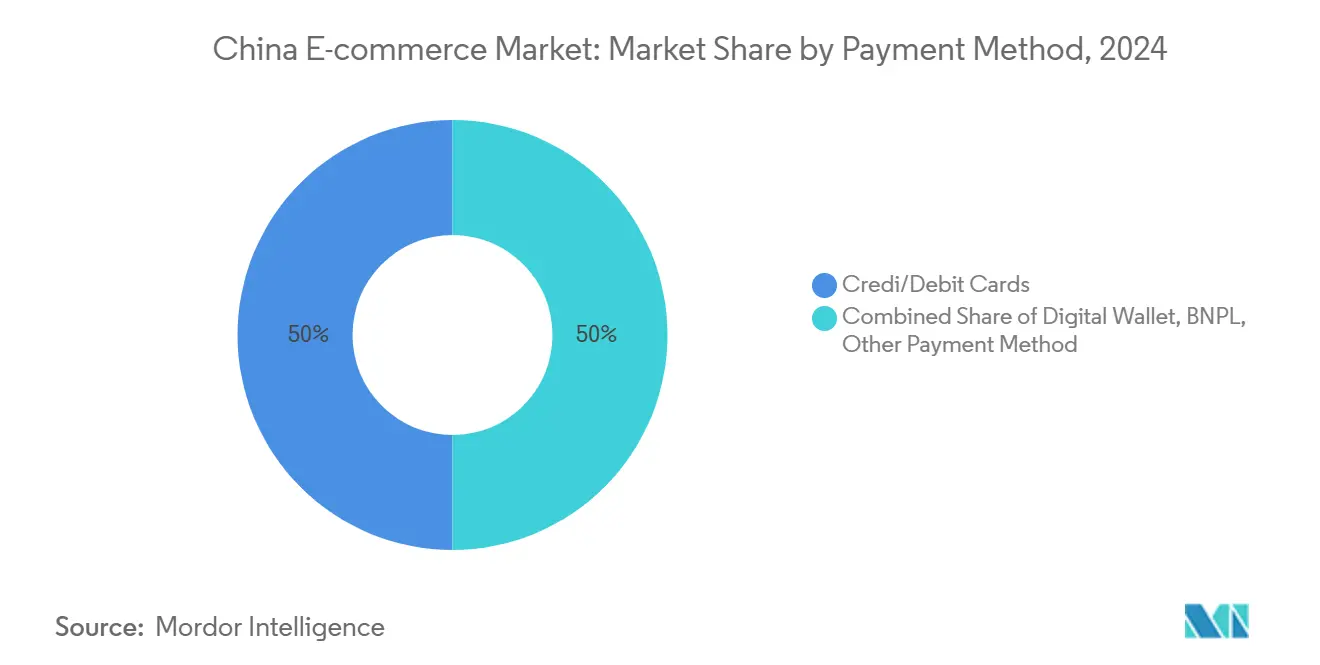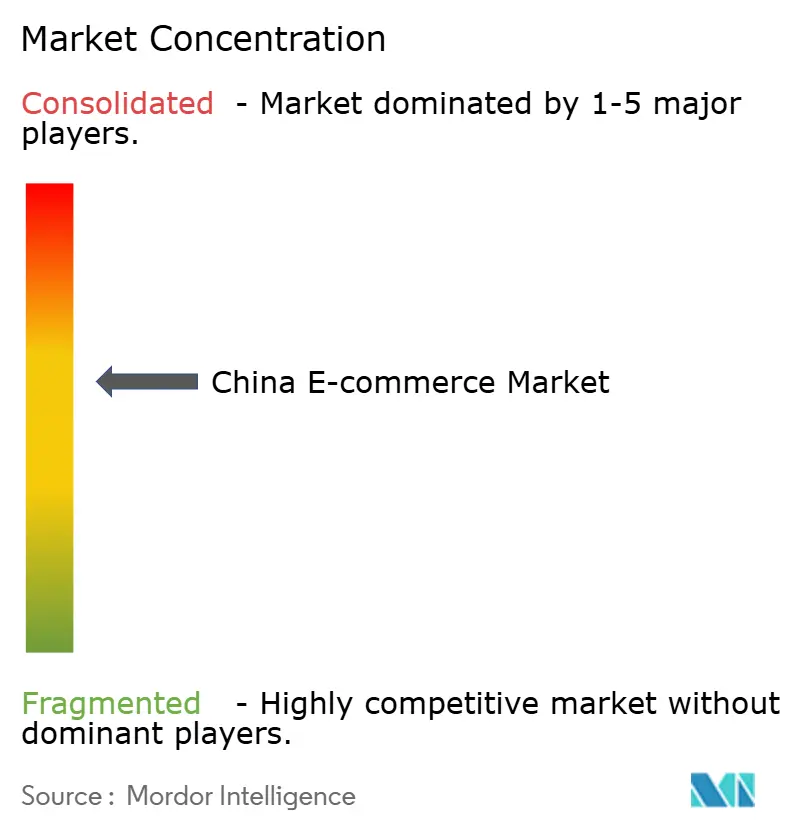
China E-commerce Market Analysis by Mordor Intelligence
The China e-commerce market size is estimated is the world’s largest digital commerce arena, valued at USD 1.53 trillion in 2025 and forecast to reach USD 2.52 trillion by 2030, reflecting CAGR of 10.42%. The China e-commerce market continues to represent almost 50% of global online transactions, supported by mobile-first usage patterns, livestream shopping adoption and integrated social-commerce ecosystems.[1]China Internet Network Information Center, “Statistical Report on China’s Internet Development,” cnnic.com.cn Strong logistics networks capable of same-day fulfillment, the expansion of private-traffic mini-programs and broadening acceptance of digital wallets all reinforce scale advantages. Competitive dynamics have shifted from discount wars to ecosystem optimisation as leading platforms protect merchant margins and invest in artificial intelligence. Intensifying regulatory oversight on data security and fair competition adds compliance costs but ultimately encourages sustainable operating models, while lower-tier cities and rural areas supply the next wave of shoppers, de-risking saturation in Tier-1 metropolitan centres.
Key Report Takeaways
- By business model, the B2C segment led with 88% revenue share in 2024; B2B is projected to expand at a 14.5% CAGR to 2030 as enterprises digitise procurement.
- By device type, smartphones and tablets held 68% of the China e-commerce market share in 2024, while smart-connected devices recorded the fastest projected CAGR at 10.7% through 2030.
- By payment method, cards retained 50% share of the China e-commerce market size in 2024, yet digital wallets are on track to capture 86% of transaction value by 2027, advancing at a 16.1% CAGR.
- By product category, consumer electronics accounted for 22% of the China e-commerce market size in 2024; food and beverages is advancing at a 15.8% CAGR to 2030 on the strength of same-day grocery delivery.
China E-commerce Market Trends and Insights
Drivers Impact Analysis
| Driver | (~) % Impact on CAGR Forecast | Geographic Relevance | Impact Timeline |
|---|---|---|---|
| Livestream commerce expansion in lower-tier cities drives the market | +2.8% | Lower-tier cities nationwide, spillover to rural areas | Medium term (2-4 years) |
| Same-day logistics unlocking FMCG & fresh grocery online | +1.9% | Tier-1 and Tier-2 cities, expanding to Tier-3 | Short term (≤ 2 years) |
| Private-traffic WeChat mini-program enablement for SMEs Drives the Market | +1.4% | National, with concentration in eastern provinces | Medium term (2-4 years) |
| Cross-border duty exemption driving imported cosmetics drives the market | +0.7% | Tier-1 cities and coastal regions | Long term (≥ 4 years) |
| Source: Mordor Intelligence | |||
Livestream Commerce Expansion in Lower-Tier Cities Drives the Market
Livestream retail has matured into a mainstream sales mechanism that blends entertainment, social interaction and instant purchasing. Audience engagement remains strongest in third- and fourth-tier locations where traditional retail footprints are thinner and viewers show high receptivity to community-based influencers. Platforms integrate real-time interaction, scarcity cues and localised content to motivate immediate conversion. Major brands now curate digital showrooms and partner with key opinion leaders to maintain premium positioning while accessing broader demographics. Emerging augmented-reality trials are set to raise immersion, indicating that interactive shopping will remain a structural driver of the China e-commerce market.
Same-Day Logistics Unlocking FMCG & Fresh Grocery Online
Nationwide investment in sortation centres, cold-chain hubs and intelligent route planning has reduced fulfilment windows from next-day to same-day in most Tier-1 and Tier-2 cities. Operators leverage urban front-warehouse models that sustain high-frequency orders and protect fresh-produce integrity. Instant delivery services underpin the rapid growth of online fast-moving consumer goods, deepen user loyalty and insulate leading platforms through scale efficiencies that are costly for traditional retailers to replicate. Continuous performance of this logistics backbone strengthens consumer willingness to migrate weekly household spending to the China e-commerce market.
Private-Traffic WeChat Mini-Program Enablement for SMEs Drives the Market
Mini-program storefronts inside WeChat give small and midsize enterprises frictionless access to over 1.2 billion potential shoppers, embedding discovery, purchase and payment within one super-app. Merchants harness proprietary customer data to push personalised coupons and live chat services, reducing dependence on open marketplace algorithms. Order volumes for mini-stores more than doubled over 2024, validating private-traffic engagement as an SME growth engine. The model also blends online and offline journeys, steering footfall to physical outlets and reinforcing omnichannel brand equity across the broader China e-commerce market.
Cross-Border Duty Exemption Driving Imported Cosmetics Drives the Market
Favourable duty thresholds and simplified warehouse refund policies continue to lower landed costs for overseas beauty brands. The imported cosmetics segment benefits from rising disposable incomes and a preference for premium formulations among Gen-Z consumers. Market entry still requires National Medical Products Administration registration, a barrier that protects established global suppliers with regulatory experience. Steady inflows of foreign brands diversify product choices and lift average order values, supporting long-term growth of the China e-commerce market.
Restraints Impact Analysis
| Restraint | (~) % Impact on CAGR Forecast | Geographic Relevance | Impact Timeline |
|---|---|---|---|
| Data-privacy & anti-trust regulations curbing monetisation | -1.6% | National, with stronger enforcement in major cities | Short term (≤ 2 years) |
| Weak IP enforcement deterring luxury brand presence | -0.7% | Tier-1 cities and premium market segments | Medium term (2-4 years) |
| Mobile-internet user saturation in Tier-1 cities hinders the market | -0.9% | Tier-1 cities, limited spillover to Tier-2 | Long term (≥ 4 years) |
| Source: Mordor Intelligence | |||
Data-Privacy & Anti-Trust Regulations Curbing Monetisation
Platform operators face stricter merger reviews, algorithm disclosures and user-consent requirements under 2025 data-security rules. Compliance raises operating costs and curtails aggressive tactics such as exclusive dealing or subsidy burn, slowing near-term revenue expansion. Larger incumbents absorb the cost through upgraded governance structures, whereas smaller entrants redirect capital toward legal and cybersecurity budgets, reducing funding for marketing. These rules signal the transition of the China e-commerce market from hyper-growth to disciplined expansion.
Mobile-Internet User Saturation in Tier-1 Cities Hinders the Market
Penetration in Shanghai, Beijing, Guangzhou and Shenzhen exceeds 99%, leaving limited headroom for incremental users. Acquisition spending now centres on share-shift rather than expansion, pressuring margins. As premium urban consumers demand richer experiences, platforms invest in AI-driven curation, extended-reality product trials and premium fulfilment. This differentiation strategy raises cost bases and heightens the importance of tapping lower-tier cities and rural segments to sustain China e-commerce market growth momentum.
Segment Analysis
By Business Model: B2B Acceleration Challenges B2C Dominance
B2C transactions contributed 88% of 2024 gross merchandise value, anchored by the sophisticated retail ecosystems of Alibaba, JD.com and Pinduoduo. Stable household demand, in-app media content and loyalty programmes maintain this leadership. However, B2B marketplaces are scaling rapidly on the back of supply-chain digitalisation initiatives across manufacturing clusters. Procurement teams adopt AI-enhanced sourcing tools and real-time price benchmarking, pushing the China e-commerce market size for B2B platforms toward a forecast 14.5% CAGR through 2030.
Cross-border policy support accelerates B2B exports, with more than 2,500 overseas warehouses easing last-mile delivery for Chinese producers.[2]Ministry of Commerce, “Cross-Border E-Commerce Overseas Warehouse Development,” mofcom.gov.cn Telecom majors reported CNY 278.8 billion (USD 38.78 billion) in enterprise digital-transformation revenue during 2024, indicative of rising platform adoption.[3]China Mobile Limited, “2024 Annual Results Announcement,” chinamobileltd.com As a result, B2B’s contribution to the China e-commerce market will continue to narrow the gap with consumer-centric models while generating complementary logistics scale.

Note: Segment shares of all individual segments available upon report purchase
By Device Type: Mobile Supremacy Drives Innovation
Smartphones and tablets captured 68% of 2024 transactions, with 99.7% of Chinese internet users now accessing services by mobile device. On-device biometric authentication, integrated digital wallets and 5G speeds reduce checkout friction and foster impulse purchases. The segment is projected to sustain a 10.7% CAGR, reinforcing mobile as the default gateway to the China e-commerce market.
Expansion of 5G-Advanced networks covering 95% of the population and one billion 5G subscriptions enable richer media formats, including 3D product modelling and low-latency livestreams, features unattainable on legacy desktops. Consequently, mobile remains the innovation sandbox that shapes user expectations across all other channels.
By Payment Method: Digital Wallets Reshape the Transaction Landscape
Cards retained 50% share in 2024, yet digital wallets already deliver 82% of e-commerce value and are advancing at 16.1% CAGR. Wallets link to bank accounts while embedding escrow functions, loyalty points and consumer-protection insurance that collectively elevate trust. This evolution is forecast to secure 86% of transaction volume by 2027, lifting the China e-commerce market size attributed to wallet-based payments.
The rollout of the digital yuan adds an official option for contactless retail. With 1.8 billion wallets opened and cumulative volume exceeding CNY 7.3 trillion by mid-2024, state-backed rails lower transaction fees for merchants and expand acceptance among tourists and the elderly through visual hardware wallets.

Note: Segment shares of all individual segments available upon report purchase
By B2C Product Category: Electronics Lead While Food & Beverages Accelerate
Consumer electronics held 22% share in 2024, driven by government trade-in subsidies and rapid upgrades to AI-enabled devices. High-end smartphones, foldable screens and smart-home appliances bolster basket sizes. Meanwhile, food and beverages exhibit the fastest 15.8% CAGR through 2030, with fresh-produce ecommerce exceeding CNY 700 billion (USD 97.38 billion) on the strength of same-day cold-chain delivery.
Beauty and personal care remain robust, underpinned by regulatory clarity and duty concessions that attract global brands. Fashion transitions to ultra-fast cycles as online sales approach 60% penetration by 2025. Diversification of categories broadens the China e-commerce market share for non-electronics verticals while encouraging platform cross-selling algorithms that expand average order frequency.
Geography Analysis
The China e-commerce market dominates regional peers with USD 1.53 trillion sales in 2025, equal to nearly half of global online volume. National online retail revenue reached CNY 15.42 trillion (USD 2.15 trillion) in 2023, reflecting 11% growth despite external economic headwinds. Lower-tier urban centres recorded 5.8% spending growth in 2024, outpacing Tier-1 cities as infrastructure and disposable income converge. Rural development adds 304 million internet users and CNY 2.49 trillion (USD 0.35 trillion) in ecommerce sales, illustrating the untapped potential beyond metropolitan zones.
Cross-border trade remains vibrant, with 2024 import-export volume estimated at CNY 2.65 trillion (USD 0.37 trillion), supported by consolidated manufacturing clusters in Guangdong, Zhejiang, Fujian and Jiangsu. Chinese platforms are scaling Latin-American operations; one major marketplace already holds 39 million active Brazilian users while pledging USD 150 million to local production networks. Shifts in US tariff policy accelerate diversification toward Europe and the Middle East.
Integration of the digital yuan with Hong Kong’s FPS and Macau’s digital pataca pilots further simplifies regional settlement, while Belt and Road investments enhance logistics corridors to Southeast Asia and Central Asia. These developments extend the reach of the China e-commerce market beyond domestic borders and strengthen its role as a global export engine.
Competitive Landscape
Market power is moderately concentrated among three incumbents whose combined share reached 62% in 2024. Alibaba pursues a multi-year commitment of CNY 3.8 trillion (USD 5.29 trillion) for AI infrastructure while divesting non-core retail holdings to sharpen focus on cloud and logistics. Pinduoduo, having temporarily overtaken Alibaba’s market capitalisation in 2024, recalibrates its “thousand-billion support” plan to relieve merchant cost pressures after margin contraction linked to higher US tariffs. JD.com sustains double-digit revenue growth by leveraging premium fulfilment and first-party inventory control, positioning itself as the trusted choice for authentic goods.
Short-video challengers Douyin and Kuaishou channel consumer attention into closed-loop shopping experiences, spending billions on merchant subsidies to gain share within the China e-commerce market. Strategic alliances emerge: Taobao collaborates with social-shopping start-ups to embed commerce links directly into user-generated posts, raising click-through ratios by 20%. Meanwhile, heightened regulatory scrutiny encourages transparency, compelling platforms to publish ranking algorithms and ban forced exclusivity agreements.
Rural e-commerce, B2B procurement and cross-border fulfilment represent white-space arenas attracting both incumbents and specialists. Companies with proprietary logistics and cloud orchestration tools enjoy durable advantages as data governance requirements elevate entry barriers for smaller contenders.
China E-commerce Industry Leaders
-
JD.com Inc.
-
Pinduoduo Inc.
-
Suning.com Co. Ltd.
-
Alibaba Group Holding Ltd.
-
Vipshop Holdings Ltd.
- *Disclaimer: Major Players sorted in no particular order

Recent Industry Developments
- May 2025: Alibaba’s Taobao & Tmall Group launched the “Red Cat” initiative with RedNote, embedding shoppable links inside social content; the programme doubled engagement and raised conversion, reinforcing social-commerce synergies.
- May 2025: China’s National Intellectual Property Administration issued the 2025 IP Nation Building Plan to fast-track AI and blockchain patent examinations, signalling policy support for e-commerce technology differentiation.
- April 2025: Major platforms discontinued “refund-without-return” policies, marking a shift toward profitability and reduced abuse of consumer-friendly perks.
- December 2024: The National Internet Information Office published guidelines on cross-border data-export security, clarifying compliance pathways for e-commerce enterprises operating overseas warehouses.
Research Methodology Framework and Report Scope
Market Definitions and Key Coverage
Mordor Intelligence defines China's e-commerce market as the value of all goods and services transacted online by residents and businesses located in mainland China, whether purchases occur on dedicated webstores, mobile apps, social-commerce feeds, or business procurement portals. Results are expressed in Gross Merchandise Value (GMV) at end-buyer prices and cover B2C, B2B, and C2C models, with cross-border transactions counted when the Chinese buyer or seller sits inside the jurisdiction.
Scope exclusion: purely digital content such as in-game items, crypto assets, and ride-hailing fares are outside study limits.
Segmentation Overview
- By Business Model
- B2C
- B2B
- C2C
- By Device Type
- Smartphone / Mobile
- Desktop and Laptop
- Other Device Types
- By Payment Method
- Credit / Debit Cards
- Digital Wallets
- BNPL
- Other Payment Method
- By B2C Product Category
- Beauty and Personal Care
- Consumer Electronics
- Fashion and Apparel
- Food and Beverages
- Furniture and Home
- Toys, DIY and Media
- Other Product Categories
Detailed Research Methodology and Data Validation
Primary Research
Discussions with marketplace operators, third-party merchants, payment service providers, and logistics integrators across Beijing, Hangzhou, Shenzhen, and Chengdu clarified discounting practices, average selling prices, and rural-penetration hurdles. Follow-up surveys with shoppers in tier-2 and tier-3 cities tested basket-size assumptions and mobile-only behavior, allowing us to fine-tune conversion ratios suggested by secondary data.
Desk Research
Analysts began by collecting macro signals from government bodies such as the National Bureau of Statistics of China, the Ministry of Commerce, and the China Internet Network Information Center. We then pulled trade and tariff flows from UN Comtrade and customs bulletins to gauge cross-border weightings, complemented by consumer-spending series from the People's Bank of China and the World Bank. Company filings on Alibaba, JD.com, and PDD Holdings, plus earnings transcripts, fed price-volume benchmarks, which were further enriched through paid feeds like D&B Hoovers for private-firm revenue splits. News archives in Dow Jones Factiva and industry notes from trade groups such as the China Chain Store and Franchise Association rounded out adoption trends and policy updates. The sources listed illustrate our evidence base; additional datasets were also referenced where material.
Market-Sizing & Forecasting
A top-down construct converts official online-retail receipts and B2B e-invoice tallies to GMV, after which channel-specific mark-ups adjust for service fees and return cycles. Supplier roll-ups of leading platforms, sampled ASP × order-volume checks, and import duty statistics serve as selective bottom-up counterpoints that validate and recalibrate totals. Key model drivers include smartphone penetration, digital-wallet share of checkout, rural broadband coverage, live-commerce stream hours, and discretionary income per capita; each is projected through 2030 using multivariate regression backed by consensus expectations from primary experts. Where bottom-up gaps emerge, particularly for emerging social-commerce formats, proxy metrics such as short-video ad spend are employed and then trued up against the national spending envelope.
Data Validation & Update Cycle
Outputs undergo three-layer review: automated variance scans flag anomalies against historical ratios; senior analysts interrogate outliers; and a peer panel approves the final release. Reports refresh annually, and interim revisions are triggered by material shocks such as new tax rules or platform reporting shifts, ensuring clients always receive current figures.
Why Mordor's China E-commerce Baseline Earns Decision-Maker Trust
Published estimates differ because firms choose varied scopes, input series, and refresh cadences. Some fold in digital media or report gross shipment value; others exclude B2B trade entirely. Our disciplined scope, transparent variable set, and annual reconnection with field experts anchor a balanced midpoint that executives can reproduce and defend.
Benchmark comparison
| Market Size | Anonymized source | Primary gap driver |
|---|---|---|
| USD 1.53 trn (2025) | Mordor Intelligence | - |
| USD 2.22 trn (2024) | Regional Consultancy A | Includes services like food delivery and O2O tickets outside our definition |
| USD 1.07 trn (2025) | Global Consultancy B | Focuses mainly on general merchandise B2C, omits B2B and cross-border flows |
| USD 1.41 trn (2024) | Industry Association C | Counts only B2B customs data, double counts re-exports, excludes consumer volume |
The comparison shows that headline gaps stem chiefly from what is counted rather than calculation errors. By aligning scope with on-platform GMV, applying consistent currency translation, and vetting every assumption through local interviews, Mordor Intelligence delivers a dependable, transparent baseline that stakeholders can confidently embed in strategic models.
Key Questions Answered in the Report
What is the current value of the China e-commerce market?
The market is valued at USD 1.53 trillion in 2025 and is projected to reach USD 2.52 trillion by 2030.
Which business model is growing fastest in China’s e-commerce landscape?
B2B platforms are forecast to expand at a 14.5% CAGR through 2030 as manufacturers digitise procurement.
How important are digital wallets to online shopping in China?
Wallets already account for 82% of transaction value and are expected to handle 86% of e-commerce payments by 2027.
Why are lower-tier cities critical for future growth?
Disposable-income growth in third- and fourth-tier cities now outpaces Tier-1 centres, adding new shoppers to the China e-commerce market.
How is regulation affecting platform strategies?
Data-privacy and anti-trust rules raise compliance costs, pushing companies to prioritise sustainable margins over subsidy-driven expansion.
What technologies will shape the next phase of online retail in China?
5G-Advanced networks, AI-powered personalisation, augmented-reality shopping and the digital yuan are set to redefine user experience and payment efficiency.
Page last updated on:



